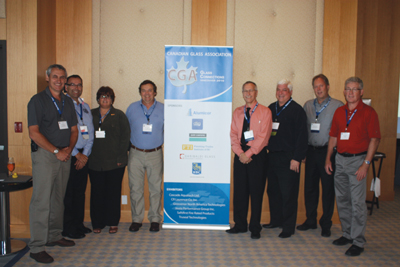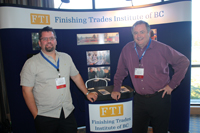
The content of the Canadian Glass Association’s (CGA) inaugural Glass
Connections 2010 conference and trade show was so informative it
challenged many seasoned glass professionals in attendance to question
what they thought they knew about architectural glass.
Delegates from across Canada and the United States attended the first CGA conference
in Vancouver, and left with tangible benefits for the entire glass industry.
The content of the Canadian Glass Association’s (CGA) inaugural Glass Connections 2010 conference and trade show was so informative it challenged many seasoned glass professionals in attendance to question what they thought they knew about architectural glass.

|
| Glass Connections was a very important event for the CGA, drawing together many board members from across the country. From left: Richard Neal (director), Richard Verdon (president), Zana Gordon (executive director), Dave Langton (1st vice president), Stephen Hargrove (director), Dave Husson (past president), Dennis Haatvedt (director) and Alan Ryland (director). All photos by Rich Porayko. Advertisement
|
CGA Technical Committee member Leonard Pianalto of Read Jones Christoffersen Consulting Engineers chaired the event, which took place at the Grand Villa Hotel & Casino in Metro Vancouver, B.C., on Sept. 30, 2010. CGA president Richard Verdon of RSVP Agency Inc. opened the proceedings and welcomed the 100 delegates by thanking the crowd for its support and participation.
“We have endeavoured to make this a cost-effective and highly focused one-day conference that combines several elements traditionally found on longer programs,” said Verdon. “It is a valuable educational forum designed to maximize your investment in time.”
Glass Connections is a national conference developed by the CGA and it will be rolled out to other regions in the coming years. The next event will be held in May 2011 in Toronto.
“Glass Connections 2010 is more than just an industry event,” said Canadian Glass Association executive director Zana Gordon. “It represents a promise that we made at the beginning of the year to reach out to glass professionals across the country, solidify our status as a national association for glaziers, and provide tangible resources to help the industry.”
The CGA Technical Committee is chaired by Leonard Pianalto and includes Steve Gusterson of Alumicor, Brent Harder of Ferguson Glass and Daniel Morin. “The CGA Technical Committee did an amazing job in selecting interesting topics and well-respected speakers,” said Gordon.
“The CGA board would like to acknowledge the support of our sponsors, Dow Corning, DSG Custom Glass, Finishing Trades Institute of BC, Alumicor, Garibaldi Glass and Ray-Bar Engineering. The board would also like to thank RBC for their sponsorship and their door prize contribution.”
Gordon continued, “The Canadian Glass Association worked very hard to ensure the first conference was a model to build on to provide the host province with relevant topical discussion to attract attendees while providing value to sponsors and exhibitors.”
Christopher Barry, director of technical services for Pilkington NSG, provided a fascinating presentation entitled “Raise Your Window Performance to Meet Tomorrow’s New Levels,” which focused on glass clarity, colour, reflection, thermal insulation, solar control and passive solar gain.

|
|
| Christopher Barry, director of technical services for Pilkington NSG, presented on “Raise Your Window Performance to Meet Tomorrow’s New Levels.”
|
“Glass is always changing,” said Barry. “There are one billion ways to fill a hole in the wall with a glass product; however, there is only one best way. How do you know which one is best? And when you order it how do you know you’ve received it if the coating is invisible?
“If you want clarity, get a low iron glass. We don’t see glass. We only see what is transmitted through the glass plus what is reflected by the glass. When you are looking through 5 to 20 millimetres of glass you aren’t going to see much colour. If you screenprint white ceramic frit behind 19-millimetre glass, sunlight is going to pass through the glass, pick up a tiny bit of colour, reflect off the white ceramic frit and back through the 19 millimetres, so we are really looking through 38 millimetres of colour. That’s when it is really important not to mix and match suppliers. If you want to get rid of the glass colour altogether, screenprint it solid black, which removes all reflection.”
Optical illusions occur for a reason. It’s not your eye playing tricks on you, it’s your brain, and Barry displayed several vivid examples demonstrating just that. “Colour differences can appear greater or smaller depending on the surrounding colours,” said Barry.
Lesson learned? You must examine glass in the lighting and installation in which it will be seen. “If you put a piece of glass on a white piece of paper under fluorescent lights it will show you exactly what a piece of glass on white paper under fluorescent lights looks like,” said Barry.
Other key takeaways from Christopher Barry’s presentation:
- Krypton is a better performing gas than argon, although it is much more expensive.
- Every window should be double glazed with low-e. A high-performance coating always makes an IG better. “Two equal three when you use low-e.” (A standard double-glazed unit with one low-e coating on the third surface is as effective as a triple-glazed unit with no low-e.)
- If an IG manufacturer can’t make a unit that will seal argon, then they shouldn’t be making sealed units.
- IG manufacturers should always print their names on their spacer bar for traceability. Glazing contractors should avoid suppliers that don’t permanently identify their product.
- PVB lamination may stop 99.9 per cent of UV; however, it only stops 67 per cent of fading.
- In Canada, heating is more expensive than cooling, so it is important to use a low-e with a high Solar Heat Gain Coefficient (SHGC).
- If two low-e coatings are going to be used in a single IG unit, the second coating should be a hard coat on the fourth surface. Sealed units should not have low-e on both the second and third surfaces of the same unit.
John Carpenter, president of Clearstream International Products, a representative of Schott Architectural and Schott Solar in eastern Canada, presented an intriguing session on “Harvesting Sunlight.”
“The architectural industry is full of open-minded adrenalin-charged people who by their own nature and the nature of their business are always searching for something better and unique in design and application,” Carpenter told his audience.
Carpenter’s presentation focused on current glazing techniques that are being used to capture and manage solar energy. From Building Integrated Photovoltaics (BIPV) to diffusing light, Carpenter emphasized the opportunity to harvest the sun, not fight it.
“Daylighting is extremely beneficial to building occupants in increasing comfort, reducing absenteeism and increasing productivity,” said Carpenter. “Operating costs are lower and the building is worth more. When you bring daylight in it has a profound effect on the people within. In Europe, they have been aware of this for years. Germany has mandated that workers must be within a certain number of metres of a source of natural light.”
In order to effectively capture daylight, it is necessary to diffuse the light, eliminate glare and control solar heat gain.
Other new developments from Schott included switchable glass, bird-friendly windows and digitized glazing, which is the precise image transfer over large glass surfaces without silk screening.
Would you hire an HR person to do your accounting? Probably not. Cori Maedel, CEO of Jouta Performance Group, presented on the “High Cost of Losing People: How to Recruit and Retain Top Talent.” Maedel believes that companies need to hire based on fit to the culture first and then skill. “It is imperative that company owners drive the culture and make sure it is understood and adopted by HR,” said Maedel.
“People want to know more about the company they are with. If they have the big picture view, they are way more vested and feel like they are part of the company. They feel empowered.”
The Top 5 Reasons People Stay With an Employer
Christopher Barry filled in for Margaret Webb on behalf of the Insulating Glass Manufacturers Alliance (IGMA) and provided the findings of the IGMA 25 Year Correlation Study, which monitored 2,400 IG units representing 140 buildings in 14 cities.
At one time, the only criteria used for defining a failed unit were if the IG unit was fogging or if the spacer bar was travelling. According to IGMA, an IG failure is now defined as a unit with fogging, damaged coating, displaced spacer, loss of adhesion or any other impairment such as containments or argon loss.
“Driving around I see glass units that are concave or convex, which means that the seal is good,“ said Barry. “A flat unit means the seal has failed.“
In general, the main factors that contributed to IG failures in the study included inadequate design for thermal stress leading to cracked glass and improper glazing. Proper glazing is critical to long-term performance.
“There is no reason today that a properly designed, properly made and properly installed unit, and all three of those factors are critical, should not have a life span in excess of 25 years,“ said Barry. “If the life span is not in excess of 25 years, someone somewhere is doing something wrong.”
The mantra of IGMA: Say what you do, do what you say and be able to prove it.
Andrew Pape-Salmon, director of the Energy Efficiency Branch of the BC Ministry of Energy, Mines and Petroleum Resources, provided what turned out to be a very interactive presentation. The session outlined government, utility and private sector standards and measures to improve energy efficiency for new and existing buildings in British Columbia, including information about product requirements under the B.C. Energy Efficiency Act.
In addition, Pape-Salmon addressed the B.C. Building Code, which requires compliance with the ASHRAE 90.1 (2004) standard for new highrise and large building construction. The presentation highlighted the efforts made to harmonize equipment regulations (Energy Efficiency Act) with building code requirements (ASHRAE 90.1). Pape-Salmon also summarized the typical technical characteristics of products that are compliant with the regulated standards in British Columbia.
“Effective Jan. 1, 2010, British Columbia became a low-e jurisdiction. Basically, every glazing product sold in B.C. must be low-e due to regulations for new and existing buildings, including highrise, lowrise, door lites, etc.”
The program is a way of showing industry and consumers which products have proven that they are energy efficient. “Energy Star is pretty simple. It is either Energy Star or it is not. You don’t have to get involved with U-values, which is good, because many people think that like R-value for insulation, the bigger the U-value, the better. Energy Star provides a mechanism for people to make decisions easily.”
The apex of the presentation and perhaps the entire day, which was a huge success, was provided by attendees who were concerned regarding compliance testing of glazing systems in order to meet new government regulations. Specifically, they were interested in the burden of responsibility of testing and who would be required to pay. The way the program is currently designed, glazing contractors would need to pay out significant hard costs for testing in order to even bid on a project.
In an age when “take 10 per cent off whatever they quoted you” seems to be commonplace, this heated discussion, and the conference in general, proved that there are still many companies passionate about this business and willing to contri-bute to and support the entire industry. •
Rich Porayko is a professional writer and founding partner of Construction Creative, a marketing and communications company located in Metro Vancouver, B.C.
richp@constructioncreative.com
Print this page
Leave a Reply